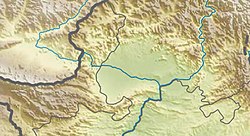
Back Takht-i-Bahi Catalan Takht-i-Bahi Czech Takht-i-Bahi German Takht-i-Bahi Spanish تخت باهی Persian Takht-i-Bahi French તખ્તેબહી Gujarati תח'ת-י בהי HE Tahti Bahi Croatian Takht-i-Bahi Italian
 A view of the site's main cluster of ruins | |
| Location | Mardan, Khyber Pakhtunkhwa, Pakistan |
|---|---|
| Coordinates | 34°17′10″N 71°56′48″E / 34.28611°N 71.94667°E |
| Type | Settlement |
| History | |
| Founded | 1st century CE |
| Abandoned | 7th century CE |
| Official name | Buddhist Ruins of Takht-i-Bahi and Neighbouring City Remains at Sahr-i-Bahlol |
| Type | Cultural |
| Criteria | iv |
| Designated | 1980 (4th session) |
| Reference no. | 140 |
| Region | Asia-Pacific |
Takht-i-Bahi (Pashto/Urdu: تختِ باہی, lit. 'throne of the water spring'), is an Indo-Parthian archaeological site of an ancient Buddhist monastery in Mardan, Khyber-Pakhtunkhwa, Pakistan. The site is considered among the most important relics of Buddhism in all of what was once Gandhara.[1]
The monastery was founded in the 1st century CE,[2] and was in use until the 7th century.[1] The complex is regarded by archaeologists as being particularly representative of the architecture of Buddhist monastic centers from its era.[3] Takht-i-Bahi was listed as a World Heritage Site in 1980,[2][4] with UNESCO describing it as "exceptionally well-preserved."[1]
- ^ a b c Cite error: The named reference
UNESCOwas invoked but never defined (see the help page). - ^ a b Takht-i-Bahi, UNESCO Office, Islamabad, Pakistan, 2002
- ^ UNESCO Advisory Body Evaluation of Takht Bhai
- ^ Khaliq, Fazal (1 June 2015). "Takht-i-Bhai: A Buddhist monastery in Mardan". DAWN.COM. Retrieved 8 November 2015.

